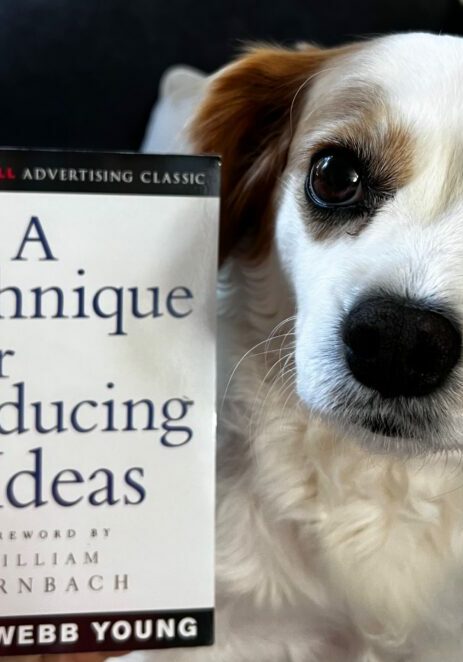A Technique for Producing Ideas by James Webb Young
In this ever-growing, constantly information-overloaded world we live in, the quest to create an original idea and be creative has never been more vital. A Technique for Producing Ideas by James Webb Young is a timeless book that holds the key to unlocking the limitless potential of your imagination.
I LOVE books like this! That has been around forever (Since 1940), and only a few folks know about it. And I was in the right group at the right moment when someone suggested this book.
What else I love about it is that it’s only 48 pages, and its trim size is 5×7, which is a relatively small book. Yet, within those pages, it’s jammed pack with one of the best summaries I’ve ever read about the process of creating new ideas.
The other interesting fact about A Technique for Producing Ideas is that at the time this book was published in 1940, it became a classic in the world of advertising and creativity.
In this book, Young presents a systematic approach to nurturing creativity and generating innovative ideas, making it an essential guide for anyone seeking to harness their creative powers.
Think of this book as a compass guiding you toward the rich landscapes of your creativity.
I was also fascinated by Young’s background in advertising. In fact, he started his career at J. Walter Thompson. If you know this book and have read it, you know the depth of the treasures within it.
I love how it takes you on a fascinating journey into how to break through your barriers to create new ideas.
If you’re anything like me, A Technique for Producing Ideas will guide you through this simple process. It will help you look at a current idea and guide you to creating your own spin and new perspective around it.
Idea-generating and creativity journeys await you!
A Book Summary to Inspire You To Read It!
Quick Summary
The book A Technique for Producing Ideas, will give you a methodical approach to fostering your creativity. What’s inspiring about this book is that Young dispels the myth that creativity, or being a creative genius, is innate. It can be learned. He introduces “the new combination” concept, where innovative ideas are born by merging existing elements in novel ways. And he gives you his five-step roadmap to get you there. Through his real-life examples, he validates his techniques. He proves that anyone can harness their creative power and cultivate innovation and groundbreaking ideas.
Who Ought to Read this Book and Why:
A Technique for Producing Ideas is a must-read for creators, innovators, and problem solvers across any discipline. Entrepreneurs aiming to broaden horizons, writers craving inspiration, and professionals seeking to smash creative blocks will uncover gems. It’s also for anyone who’s frustrated and struggles with creating new ideas and their own creativity. If you’re intrigued by unlocking your inventive potential and supercharging imagination, this book’s idea generation and creativity strategies are your toolkit. Whether you’re a visionary entrepreneur or an artist chasing sparks of brilliance, this book guides you through barriers and transforms your creative journey. It will unveil a world of limitless creativity for you.
Things You Will Discover:
The 5-Step Process of Breaking Through Your Barriers to Create New Ideas:
- Gather Raw Material: Immerse yourself in diverse fields to gather a mosaic of information.
- Digest the Material: Deeply contemplate and analyze the collected data, seeking connections.
- Incubation: Let ideas marinate in your subconscious, allowing unexpected breakthroughs.
- The Birth of the Ideas (or the Eureka Moment): The subconscious unveils a new combination, a foundation for a creative idea.
- Development of the Idea – Validate, test, and refine your idea for practicality and viability.
A Technique for Producing Ideas Table of Contents:
How It Started
The Formula of Experience
The Pareto Theory
Training the Mind
Combining Old Elements
Ideas are New Combinations
The Mental Digestive Process
“Constantly Thinking About It”
The Final Stage
Some After-Thoughts
Young also tells some interesting, innovative idea stories. Such as how radio technology collided with toothpaste and a radion engineer created the toothpaste tube.
My personal favorite that’s NOT in the book is how the chocolate chip cookie was invented by a dietician – Ruth Wakefield, in 1930. She and her husband bought the Toll House Inn, which became famous for Wakefiled’s desserts. She wanted to offer guests something different. So she took an ice pick to a block of chocolate and added it to her cookie dough, and that’s how the chocolate chip cookie was born. Later, Nestle approached her for the rights to her recipe and started creating chocolate chips and printing her recipe on the back of every bag. It’s still there to do this day.
I love these invention stories because it just goes to show you many inventors were not born that way. They invented something either by accident, like George de Mestral, who created velcro. After hunting with his dog in Switzerland, they both were covered in burs. Instead of brushing them off, he studied them under a microscope and created an alternative to zippers, using tiny hooks that would catch in the material’s loops. Kind of cool, right?
Now, what are you going to create?
Inspiring Book Quotes:
What’s An Idea?
“An idea is nothing more or less than a new combination of old elements (Quoted from Vilfredo Pareto).”
The First Things to Learn:
“In learning any art, the important things to learn are, first, Principles, and second, Method. This is true of the art of producing ideas.”
Master The Words:
“We tend to forget that words are, themselves, ideas. They might be called ideas in a state of suspended animation. When the words are mastered, the ideas tend to come alive again.”
Create a New Combination:
“In advertising, an idea results from a new combination of specific knowledge about products and people with general knowledge about life and events.”
Creative Characteristics:
“Every really good creative person … has always had two noticeable characteristics. First, there was no subject under the sun in which he could not easily get interested — from, say, Egyptian burial customs to modern art. Every facet of life had a fascination for him. Second, he was an extensive browser in all sorts of fields of information.”
Producing Ideas:
“The production of ideas is just as definite a process as the production of Fords. The production of ideas, too, runs on an assembly line; in this production, the mind follows an operative technique that can be learned and controlled, and its effective use is just as much a matter of practice in the technique as is the effective use of any tool.”
This Matters:
“The principle of constantly expanding your experience, both personally and vicariously, does matter tremendously in any idea-producing job. Make no mistake about that.”
A Good Idea:
“A good idea has self-expanding qualities. It stimulates those who see it to add to it.”
It’s About The Method:
“What is most valuable to know is not where to look for a particular idea, but how to train the mind in the method by which ideas are produced; and how to grasp the principles which are the source of all ideas.”
Reading The Dictionary:
“Thus, words being symbols of ideas, we can collect ideas by collecting words. The fellow who said he tried reading the dictionary but couldn’t get the hang of the story simply missed the point: namely, that it is a collection of short stories.”
Learn to Love Yourself:
“… I propose to assume that if a man (or a woman) is at all fascinated by advertising, it is probably because he is among the reconstructors of this world. Therefore, he has creative powers… that may be increased by making a deliberate effort to do so and by mastering a technique for their better use.”
About the Author – James Webb Young
James Webb Young (1886-1973) was an American advertising executive at J. Walter Thompson who became First Chairman of The Advertising Council. James Young served the advertising world in several capacities, influencing the development and history of the industry at each step. In 1912, Young joined J. Walter Thompson as a copywriter, writing several memorable advertisements such as the “Curve of a Woman’s Arm.” He quickly rose through the ranks to become a vice president and remained a senior influence on the affairs of the agency until 1964.
One of his greatest contributions to J. Walter Thompson was in supporting and directing the agency’s international expansion efforts. He was inducted into the American Advertising Federation Hall of Fame. Young received many honors and awards, including the Advertising Man of the Year Award in 1946 and the Advertising Awards Gold Medal for “outstanding achievements of a lifetime” and most particularly for his notable contributions during the war.
Where I Would Recommend Getting Your Copy:
A Technique for Producing Ideas by James Webb Young
Other Books About Writing I’d Recommend:
The War of Art by Steven Pressfield
Put Your Heart Where Your Ass Wants to Be by Steven Pressfield
Big Magic: Creative Living Beyond Fear by Elizabeth Lesser
The Creative Habit: Learn It and Use it for Life by Twyla Thorp
The Artist’s Way by Julia Cameron
Soulfully Yours,
Previous Book Review

A Technique for Producing Ideas by James Webb Young

Hey there, I'm Shannon! Being a voracious reader and passionate about learning, I started this site in the hopes of sharing my thoughts and my love of inspiring nonfiction books that can help you. It's kind of like Buddha meets business. I truly hope you enjoy!
Subscribe to New Posts
© 2023 BooksYouGottaRead.com / SoulfulMarketing.com.
Powered by McCaffery Communications, LLC. All Rights Reserved.

